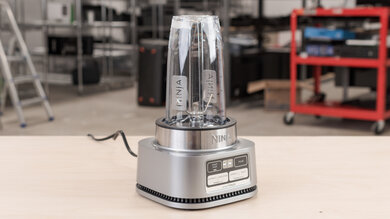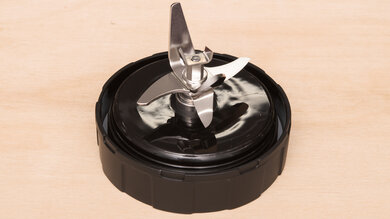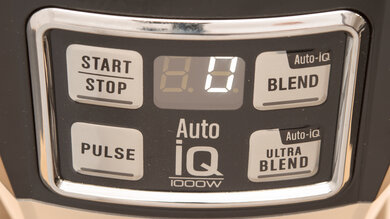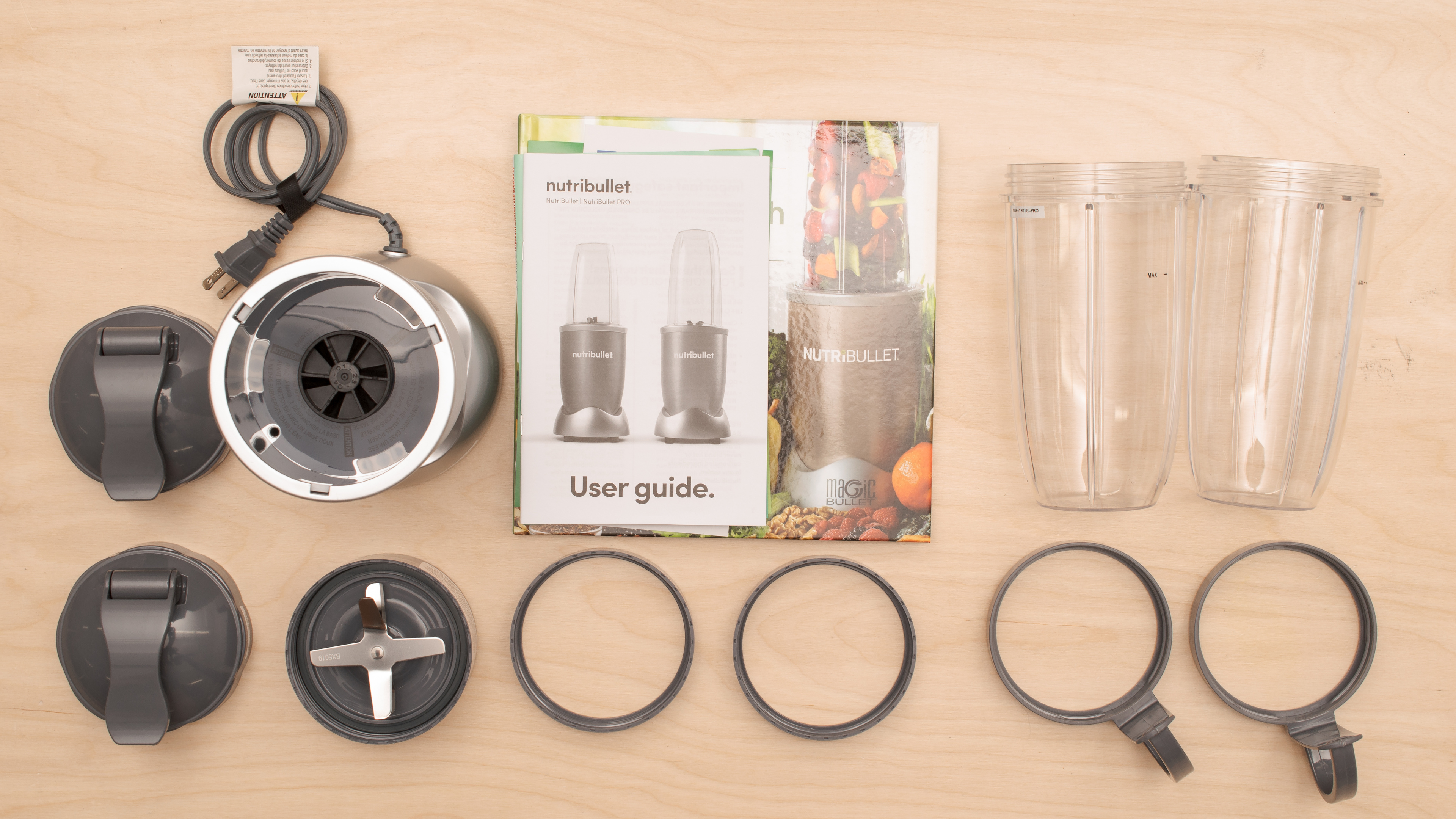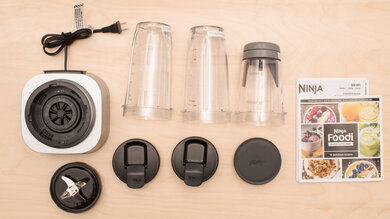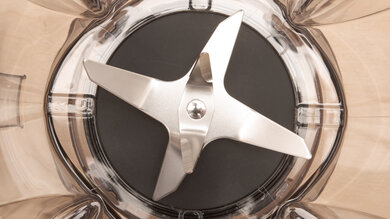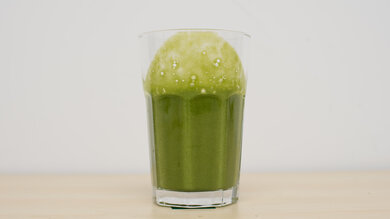If you're looking for a single-serve smoothie maker or want a full-size blender below the Vitamix price point, you might choose between Ninja and nutribullet (and its sister brand Magic Bullet). These brands both make a large variety of blenders, especially personal and full-size blenders, and most models from both brands fall into the mid-range price category. We recommend Ninja blenders more often for reasons you can check out below. However, both brands have design quirks, strengths, and weaknesses, so it depends on what you're looking for.
If you want to see more of what each brand has to offer, check out our recommendations for the best Ninja blenders and the best nutribullet and Magic Bullet blenders.
Test results
Personal Blenders
Nutribullet and Ninja both make personal or bullet blenders. These small-capacity blenders were originally designed for preparing single-servings of smoothies and protein shakes, but the manufacturers advertise some models for a wider variety of blends. There are a few common differences between Ninja and nutribullet (or Magic Bullet) personal blenders, and we recommend Ninja more often.
Blade design
Personal blenders from both brands have a similar design. There are six blades angled in different directions to help create a vortex, and the blade assemblies attach to the jars like lids.
However, Ninja blade assemblies are dishwasher-safe, and nutribullet's aren't, even though lids and jars usually are for both brands. This adds an extra step when cleaning a nutribullet blender, even if you put the other components in your dishwasher. However, nutribullet's blade design makes cleaning by hand easier since the blades are dull. If you hand-wash your Ninja's blades, you must be careful not to cut yourself.
Ease of use
Unlike nutribullet, Ninja makes personal blenders with control panels, digital displays, and buttons for different blending programs. Ninjas sometimes have pulse mode, which helps process hard or chunky ingredients like ice and frozen fruits.
Blending programs also mean you don't need to babysit your blender while it runs since it'll stop automatically at the end of the program. However, even though nutribullet and Magic Bullet blenders don't have blending programs, many stop automatically after one minute of blending. Because of that, Ninja's blending programs for different recipes, like 'Extract' and 'Smoothie', aren't such a big advantage.
However, watch out for blenders like the Ninja Fit and Ninja Nutri-Blender Plus, which require you to keep your hand on the blender for it to run, which is the least convenient design from either brand.
Ice
nutribullet blenders aren't intended for crushing ice without liquid in the jar. You can add ice cubes and frozen fruit into a smoothie recipe, but they aren't meant for preparing crushed ice for frozen drinks or to add to cocktails. However, most of Ninja's personal blenders are well-suited for making small batches of crushed ice.
Fibrous ingredients
Regarding blitzing fibrous ingredients like leafy greens, blueberries, and apple skins, Ninja and nutribullet perform similarly. Neither brand offers an advantage over the other if you're looking for the smoothest smoothies with stubborn ingredients.
As you can see in the videos below, the nutribullet Pro 900 (left) and the Ninja Foodi Power Nutri DUO (right) take around the same time to process small batches of fibrous ingredients and produce similar results.
Noise
nutribullet and Magic Bullet blenders tend to be quieter than Ninja blenders. The Ninja Foodi Power Nutri DUO is one of the loudest blenders we've tested, and several others are on the loud side, so it's a factor worth considering if you're worried about waking up your family or want to avoid an annoyingly loud blender.
The nutribullet Pro 900 (left) isn't particularly loud for a blender and is much quieter than the Ninja Foodi Power Nutri DUO (right).
Build quality
There's no big difference between Ninja and nutribullet blenders regarding build quality. Most are decently well-built, with plasticky designs but no flimsy parts. However, Magic Bullet blenders usually feel cheap compared to the pricier nutribullet line or Ninja's selection.
Dimensions
Magic Bullets are generally smaller than nutribullet and Ninja models if you want the smallest personal blender. Otherwise, Ninja and nutribullet blenders come in similar sizes.
Accessories
Most personal blenders from both brands come with single-serve blending jars and resealable lids. The best personal blender from Ninja, the Ninja Foodi Power Nutri DUO, comes with a special jar with arms inside of it to stir ingredients, which is very useful for recipes like nut butter. On the other hand, some nutribullet blenders come with cup rings, which attach to the lip of the blending jar so you can comfortably use it as a cup at home.
Ninja vs. Nutribullet: Which brand should you buy?
Ninja blenders are better for most people since they don't have any restrictions around ice crushing, and you can put the blades in your dishwasher.
nutribullet blenders are better for people who want a quieter machine. Because of the duller blades, you might also like nutribullet over Ninja if you hand-wash your blender. If you want something small and cheap, consider a Magic Bullet blender.
Here's a comparison of the strengths and weaknesses of each brand. It can give you an idea of which brand is better for your needs, but remember that performance and features vary between models.
| Ninja | nutribullet | Magic Bullet | |
|---|---|---|---|
| All parts dishwasher-safe | X | ||
| Easy hand-washing | X | X | |
| Blending programs | X | ||
| Crush ice for cocktails or slushies | X | ||
| Make well-blended smoothies | X | X | X |
| Quieter | X | X | |
| Better build quality | X | ||
| Smaller | X | ||
| Cheaper | X |
Full-Size Blenders
nutribullet's small line of full-size blenders are like bigger versions of the brand's personal blenders. They perform very well for blending liquidy recipes with fibrous ingredients and work well as smoothie blenders. Many can also hot blend, so they can help make smooth, pureed soups with vegetables like kale and broccoli. Ninja's full-size blenders can crush ice and often perform better for recipes like nut butter and hummus.
Build quality
Full-size Ninja blenders are usually impressively well-built. They're entirely made of plastic most of the time but feel sturdy. Nutribullet's blenders feel noticeably less premium and more plasticky.
Blade design
Many Ninja blenders have an unusual blade design. The blade assembly is a column with six sharp blades that spiral around it. This design is marketed as 'Total Crushing' blades and is usually fantastic for ice crushing. However, Ninja's full-size blenders have a low maximum blending speed, and the number of blades and very sharp edges don't make up for that when blending fibrous ingredients like fruits.
'Total Crushing' blade assemblies are removable, which would usually make cleaning easier, but since the blades are so sharp, you need to be very careful when handling them. The mechanism that connects the blade assembly and jar can trap food, so most Ninja blenders are difficult to clean by hand due to the blade design.
Nutribullet blenders have a more conventional blade design, with the blades fixed to the bottom of the jar. You can't remove the blades from the pitcher, but you can usually put both in the dishwasher. They're not as sharp, which makes them easier to clean by hand.
Controls and blending speed
Both brands make blenders with automatic blending programs, which adjust the speed and stop the blender automatically, which is helpful if you want to multitask while it runs.
Unlike nutribullet, some Ninja blenders (like the Ninja Foodi Power Pitcher System) have speed dials, so you can make small adjustments instead of choosing from a set number of speed presets. However, compared to other brands like KitchenAid or Vitamix, nutribullet and Ninja blenders have a small range of speed settings. There often isn't a big difference between the lowest and highest settings, so you don't have much control over the speed. The exception is some newer Ninja blenders, like the Ninja Chef, which has a wider range of speeds, so you can use a lower speed to avoid over-blending and ramp up to high to puree ingredients.
Fibrous ingredients
If you only use your blender for smoothies, soups, and other liquid recipes, nutribullet's full-size blenders are a better bet. If you're blending a big batch, few Ninja blenders make the perfectly smooth puree with fibrous ingredients you get from a nutribullet. Among Ninja blenders, if you want a silky smoothie with kale and fruit, it's better to avoid models with a spiral blade assembly because they have a fairly low maximum blending speed. High blending speeds help blend fibrous ingredients into a smooth puree, so from Ninja, go for options like the Ninja Chef and Ninja Foodi Cold & Hot Blender, which have blades at the bottom of the jar and higher max speed settings.
Ice
Nutribullet's full-size blenders aren't meant for crushing ice without liquid in the jar. Ninja blenders can be used for that purpose and usually excel at it.
Nut butter
Thick recipes like nut butter can pose a problem for some full-size blenders because ingredients can get pushed away from the blades and get stuck. Typical Ninja blenders are better for nut butter. They usually have slower blending speeds, which is useful for nut butter, hummus, and other dips and spreads, since lower speeds can help keep everything moving in a vortex instead of flinging ingredients away from the blades.
The videos below show the difference between the nutribullet Blender Combo (left) and the Ninja Foodi Power Pitcher SS201. The Ninja makes smoother nut butter more quickly and with less effort on your part.
However, if you're not as concerned about jar capacity, both brands make blenders that are better for nut butter. The nutribullet Rx initially blends at a fast speed but automatically adjusts and mostly blends at a lower speed. Combined with its relatively small 32oz jar, it's very easy to use for nut butter. Similarly, Ninja blenders like the Ninja Chef with a 14oz or 18oz 'Smoothie Bowl Maker' jar are well-suited for nut butter.
Accessories
Both brands make blenders with at least one personal jar and a bigger-capacity main pitcher, so you can easily blend single-serves like smoothies.
Ninja blenders are available with more accessories, especially for food processing. 'Foodi' blenders come with special blades for forming dough, and others, like the Ninja Mega Kitchen System, include separate food processing bowls for slicing and chopping. The Ninja Chef comes with a 'Smoothie Bowl Maker' jar to help process recipes like nut butter and hummus. If you're looking for a combo blender and food processor, Ninja has more options.
Ninja vs. Nutribullet: Which brand should you buy?
If you want to use your blender for big batches of smoothies or pureed soups, a nutribullet blender is a good choice. They can hot blend or heat ingredients and usually offer faster blending speeds, which helps process fibrous fruits and vegetables.
Most of Ninja's full-size blenders can't hot blend (with a few exceptions, like the Ninja Foodi Cold & Hot Blender). Some models don't perform well for blending fibrous ingredients at full capacity, which results in grainy soups and smoothies. However, they usually perform better for recipes like nut butter, and ice crushing is no problem. Some come with extra jars and blades for food processing, although models with many extra accessories are more expensive.
Here's a comparison of Ninja and nutribullet full-size blenders. It can give you an idea of each brand's strengths and weaknesses, but remember that features and performance vary between models.
| Ninja | nutribullet | |
|---|---|---|
| All parts dishwasher-safe | X | |
| Easier hand-washing | X | |
| Better build quality | X | |
| Hot blending | X | |
| Smoothly blend big batches of smoothies or soups | X | |
| Crush ice for cocktails or slushies | X | |
| Make nut butter | X | |
| Personal jars included | X | X |
| Food processing accessories | X |
